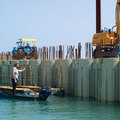 義大利政府在威尼斯潟湖(Venice lagoon)建設防洪自動水閘門的計畫,原本遭歐盟執委會及環境團體非議,認為義大利的作法違反歐盟自然保護法律。不過,在義大利當局提出一些方案以緩和與補償生態衝擊後,執委會14日表示將撤銷對此案的告訴。
義大利政府在威尼斯潟湖(Venice lagoon)建設防洪自動水閘門的計畫,原本遭歐盟執委會及環境團體非議,認為義大利的作法違反歐盟自然保護法律。不過,在義大利當局提出一些方案以緩和與補償生態衝擊後,執委會14日表示將撤銷對此案的告訴。
這項計畫是要用來減少洪氾的風險,並保護低窪的城市,但是它也同時會衝擊潟湖的生態價值,一般稱為「摩西計畫」(MoSE project)。
歐盟環境執委迪瑪斯(Stavros Dimas)表示:「我對義大利當局為這個案子所提出的一些方案表示歡迎,它的目標是限制這個重要計畫對環境的衝擊。但是我們也會緊密地追蹤他們所承諾的方案,以確保這些方案充分執行並達成目標。」
威尼斯潟湖是沿著北亞德里亞海東岸的一個範圍廣闊的半淡鹹水(brackish)海岸潟湖,位於布倫塔河(Brenta River)與皮耶芙河(Piave River)之間。三個開放的大水域形成這個潟湖的本體,周圍環繞一系列較低鹹度較小的封閉型潟湖。
威尼斯過去就有幾百年的洪氾歷史,這個城市建在水上,由許多水道替代陸地上的道路,有些地方還僅高出水面幾公分;此外,這個城市還正在下沈中。
這項計畫名為「試驗性電動模組」(Experimental Electromechanical Module),簡稱MoSE或「摩西計畫」,預定在2012年完成,是設計來排除威尼斯的洪氾。
這個計畫是由79個活動水閘門組成的系統,而系統是設計來保護通往潟湖的3個出入水口。這些堤防會停留在海床上,平常是看不見的,在漲潮或風暴來襲前,人們再將這些水閘門升高,將海洋與潟湖隔絕以降低水位;在威脅過去之後,它們會再降至水面之下。
除了威尼斯本身所具有的卓越文化與建築重要性之外,這個潟湖還庇護許多達到歐洲標準的生態重要區域,這些區域被指定為「自然2000保護區」(Natura 2000 sites)。
威尼斯潟湖庇護義大利最大的水鳥族群,已觀察到超過60種水鳥使用這個草澤及島嶼棲地來築巢、過冬、或是作為遷徙的歇腳處。在1月份,有將近13萬隻鳥會使用這個潟湖。這個潟湖也是魚類棲息地,庇護許多魚種在潟湖與海洋環境之間遷移,完成他們的生活史。
迪瑪斯表示,義大利當局授權進行水閘建設的作為,並沒有遵循歐盟保護自然的法律。義大利並未適當地評估計畫對保護區的衝擊性,並且未提出所有必要的衝擊緩解及補償方案。
因此,執委會在2005年12月及2007年7月發別發函警告給義大利當局。歷經多次與執委會的廣泛討論之後,義大利當局現在同意執行一系列方案來降低對保護區域的衝擊,其中有些已經獲得採納了。義大利同意暫停在特定時間內的某些建設工作,來降低對潟湖鳥類的干擾。 此外,義大利也同意獨立團體監督工程作業,並將設立資訊公開網站,提供進行中工事的訊息與環境監督的相關發現。最後,義大利同意將另外指定潟湖中某些區域為「重要社群場址」(Sites of Community Importance),以將之納入「歐盟棲地指示令」(EU Habitats Directive)保護,保障區域內的野生動物棲地安全。
The European Commission is closing its case against Italy over construction of moving flood protection dams in the Venice lagoon that the commission and environmental groups said violated EU nature protection laws.
The dams are intended to reduce the risk of flooding, and so protect the low-lying city, but at the same time they have an impact on the ecological values of the lagoon. As a result of measures now proposed by the Italian authorities to limit the extent of damage to the ecosystems and compensate for the impact, and in view of the objectives of the project, the commission said Tuesday it is closing the case against the so-called MoSE project.
European Environment Commissioner Stavros Dimas said, "I welcome the measures now proposed by the Italian authorities in this case, aimed at limiting the environmental impact of this significant project. We will, however, follow the promised measures closely to ensure they are fully implemented and achieve their objectives."
The Venice lagoon is an extensive brackish coastal lagoon along the eastern coast of the northern Adriatic Sea, between the mouths of the Brenta and Piave rivers. Three large, open waterbodies form the actual lagoon, surrounded by a chain of smaller, closed lagoons of lower salinity.
Venice has a history of flooding going back hundreds of years. Built on water, the city has canals instead of roads and sits only centimeters above sea level in some places. In addition, the city is sinking.
Scheduled for completion in 2012, the the Experimental Electromechanical Module, or MoSE, project is designed to eliminate flooding in Venice.
The project consists of a system of 79 mobile barriers designed to protect the three entrances to the lagoon. The barriers will stay on the seabed, invisible until high tides and storms are forecast. They will then be inflated, blocking the sea from the lagoon and reducing high water levels. After the threat has passed, they will be lowered beneath the waters again.
In addition to the outstanding cultural and architectural importance of Venice, the lagoon hosts areas of ecological importance at the European level, designated as Natura 2000 sites.
The Venice lagoon hosts the largest population of water birds in Italy - more than 60 species have been observed using the salt marsh and island habitats for nesting, over wintering, or as stopover points during migration. In January, as many as 130,000 birds make use of the lagoon.
The lagoon also serves as a productive fish habitat, hosting many species that migrate between lagoon and sea environments to complete their lifecycles.
Dimas says that in authorizing the construction of the barriers, the Italian authorities did not correctly follow EU laws for the protection of nature. Italy inadequately assessed the impact of the project on the protected areas and failed to propose all the necessary mitigation and compensation measures.
As a result, the Commission sent written warnings to the Italian authorities in December 2005 and again in July 2007.
Following extensive discussions with the commission, the Italian authorities have now agreed to implementing a series of measures, some of which have already been adopted, to limit the impact on the protected areas.
Italy agreed to the suspension of certain construction works at specific periods to reduce the disturbance on birds in the lagoon.
Authorities agreed to the monitoring of construction by independent bodies and setting up a website, open to the public, to provide information on the ongoing works and the findings of the related environmental monitoring.
And finally, Italy agreed to the designation of additional areas in the lagoon as Sites of Community Importance protected under the EU Habitats Directive, a law that safeguards wildlife habitat.


